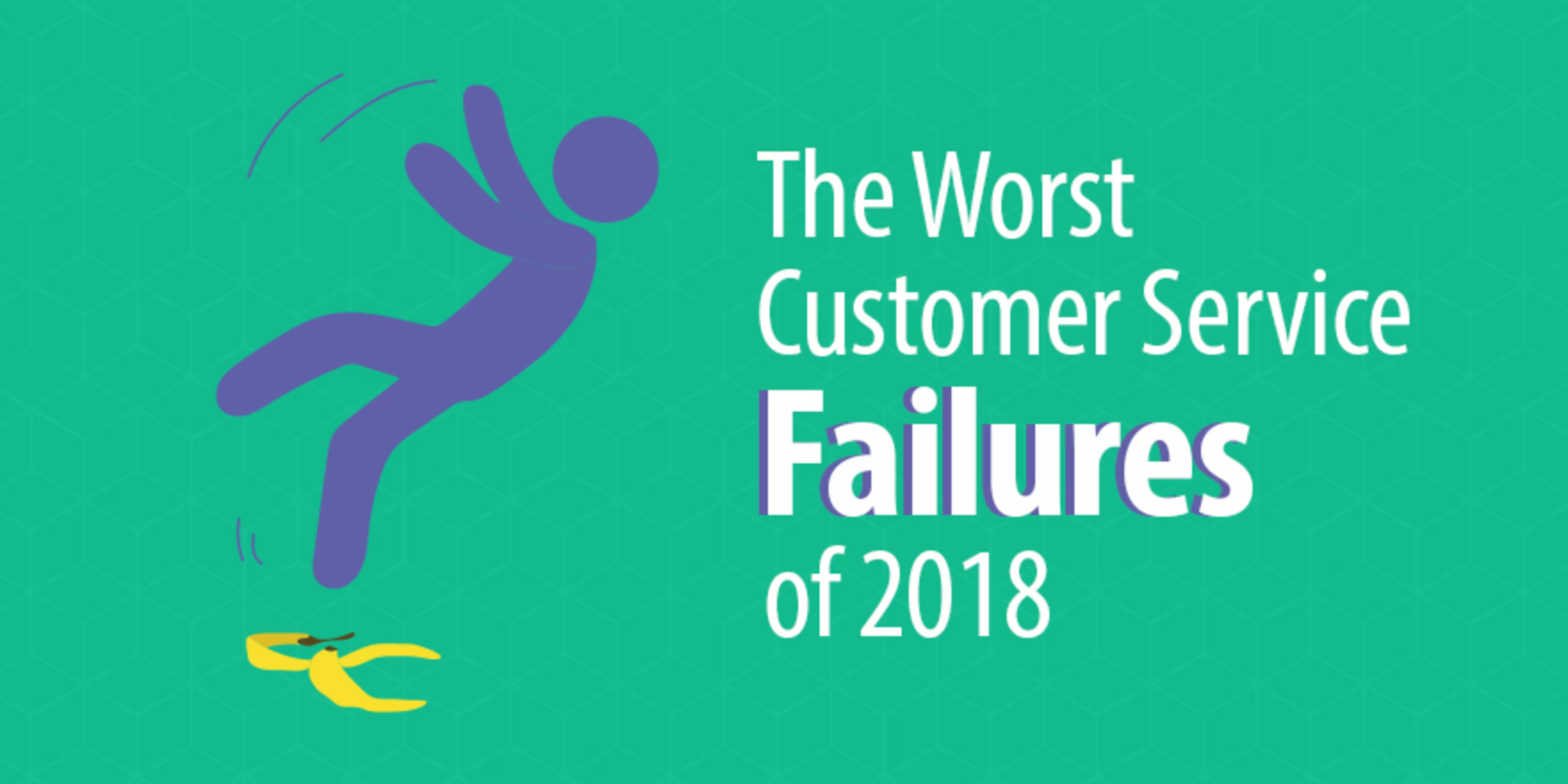Prussian and German statesman Otto von Bismarck said: “Only a fool learns from his own mistakes. The wise man learns from the mistakes of others."
For customer service pros, there were plenty of mistakes to learn from in 2017.
I've gathered three of the biggest customer service failures of the past year (in order of most to least egregious) and paired them with tips on how customer service reps can do better in 2018.

As researchers learned in the '90s, a paradox exists in customer service recovery. You can actually handle failure well enough to boost customer satisfaction, trust, and loyalty to higher levels than if you'd never failed in the first place.
1. United bloodies passenger
Warning: video depicts graphic violence.
What happened
In April, United Airlines asked two security guards to forcibly remove 69-year-old Kentucky doctor David Dao from a flight. In the process they broke his nose, gave him a concussion, and knocked his teeth out.
His crime? Not giving up his seat for a United employee.
It's hard (and horrifying) to imagine a worse customer experience than being physically injured for refusing to leave a flight you booked and paid for. United's initial response blamed Dao for not obeying instructions, saying that he “refused to leave."
In a later statement, United CEO Oscar Munoz said "This is an upsetting event to all of us here at United. I apologize for having to re-accommodate these customers."
House transportation committee chair Bill Shuster admonished Munoz and other airline executives to “seize this opportunity" to improve customer service. Munoz then promised to increase United's limit on payments to customers who give up seats on oversold flights to $10,000 and improve employee training.
How to do better
On the Human Duct Tape podcast, Jeanne Bliss interviewed Diane Mager, CEO of the Customer Experience Professionals Association, about the incident.
In Mager's opinion, United's first misstep was saying “This shouldn't have happened." Mager points out that the statement isn't really an apology. It's impersonal, and didn't validate "how we were all feeling" about what happened.
Munoz's statement failed to address the problem at hand. The other customers were re-accommodated. Dao needed reconstructive surgery to be able to breathe correctly.
Doing better than United here is relatively simple. When you mess up, respond immediately with a full, humble acknowledgement of you or your company's mistake and remorse.
In the end, your relationship with customers works a lot like any relationship. When you hurt a friend, do you offer them a vague, insincere apology? Of course not. For the same reason, when you upset your customers, it's important to apologize correctly in order to repair that connection.
2. You can't sit with us: Marriott edition

A St. John resort battered by waves (Source)
What happened
This year, Hurricane Irma's 185-mph winds destroyed half of the homes on St. John, one of the Virgin Islands. After the airport closed, Marriott sent a ship to rescue travelers who were stranded nearby on St. Thomas.
The catch? The crew only let Marriott guests on board, despite having room for guests staying on other properties.
Cody Howard was in the area to record the storm and was among those Marriott left behind. "It was really hard to see people with kids and elderly people who don't have anywhere to stay get turned away by this boat," Howard told The Washington Post. “For some people, that was the only [glimmer] of hope. After the boat left, they just felt hopeless and helpless."
“Isn't [it] possible that some of these people could have stayed a Marriott property in the past?" Richard Shapiro asked about the misstep. “Perhaps they were loyal Marriott customers and the hotel on St. John was fully booked? The proper definition of a customer is that all people are customers. Show me the rule that a person is only considered a customer if they buy today."
How to do better
One interesting thing about this situation is that Marriott may not have been able to do anything differently in the moment. Tim Sheldon, president of the Caribbean and Latin America for Marriott International, spoke with Forbes about what happened.
“The security personnel employed by the dock company would not—and we asked them repeatedly–allow [the non-Marriott guests] through the port gates and boarding area, because they were not on the manifest we prepared in advance, as a requirement for the boat to depart for international waters. The general managers who run our hotels on St. Thomas tried to work with dock personnel to allow them to get on the ship—we certainly had room aboard, which makes this both frustrating and disheartening."
A statement from the company hinted at this. “The Marriott team on-the-ground was told they had no authorization to board additional passengers who were not on the manifest. This was enforced by dock security."
But, this fact could have—and probably should have—been made clear. If there are factors beyond your control at play, make sure you state what prevented you from doing the right thing loudly and clearly.
To prevent future PR problems, Hotel Management recommends that Marriott proactively establish good relationships with dock companies ahead of time.
3. "You hate me and I hate you."
What happened
Beyond shady pricing practices and generally abhorrent customer treatment, Comcast also put its Xfinity internet service customers through a 90-minute internet outage in November.
“I know it's redundant," Stephen Gibson wrote when asked for his opinion about the worst customer service failure of 2017. “But I'd like to send some scorn Comcast's way."
The Founder of creative startup blog Vyteo went on to say:
“Their business models and pricing packages are designed to be as deceptive as legally possible. I (and everyone else) now pay 2-3 times the price of their advertised rates. I once filled out a feedback form with the words 'You hate me and I hate you.' That sums up the customer experience with Comcast."
How to do better
When you start out with a good relationship, customers tend to be more patient with inevitable failures. Unfortunately, Comcast has not built that kind of goodwill with its customers. When Harris Poll ranked the top 100 most visible companies in order of best reputation to worst, Comcast is in 90th place.
According to Nielson, many companies overlook “one of their greatest assets when it comes to reputation management: their employees." That certainly seems to be the case with Comcast. The company has a 3.4-star rating on Glassdoor. When you filter the reviews for jobs with “customer" in the title, the rating drops to 3.1 stars.
When it comes to protecting your customer reputation, employees both protect against and introduce risk. This means that attracting top talent should be one of a company's chief goals. According to Nielsen, “Being seen as a fair employer that cares about its employees is key to getting the right people in the door."
Treating employees well attracts other, high-quality employees who treat each other, and customers, well. It's a virtuous cycle that you can begin at any time.
Additional tips
Whether or not your customer service failure evokes the three summarized here, there are a few general actions you can take to handle it well.
Have a plan in place
When disaster strikes, “In the heat of the moment, with so much emotion flying around, it's hard for even the most seasoned and even-tempered customer service professionals to do their best–unless preparations have been made and a structure put in place ahead of time," Micah Solomon writes for Forbes.
Starbucks has just such a plan, paired with an appropriate acronym to help employees remember what to do: LATTE.
Listen to the customer
Acknowledge the problem/situation
Take action and solve the problem
Thank the customer
Explain what you did
“Good companies have a protocol in place to recover from their failures," Claudio Garcia wrote. “Experience companies—the truly exceptional examples of customer-focused organizations—have honed their recovery processes to the point where the recovery itself feels like a logical extension of the company's customer experience."
Offer them something
In addition to apologies, consider offering your customers something of value to smooth things over and make them feel valued. Effective sales and marketing cost money, but it's likely much cheaper in the long run to shell out for refunds, credits, and discounts to keep current customers than spending what takes to acquire new customers.
If you want to turn a disaster into an opportunity, you can't just offer customers a simple one-for-one remuneration. As Garcia notes: “Ultimately, the fix isn't memorable: You don't hear customers raving about the time the hotel gave them $20 because their room wasn't ready."
Instead, consider what it would take for the customer to be so delighted by the fix that they don't remember the initial problem.
Set up a DIY help station
According to Harvard Business Review, self-service interaction costs pennies, while live service—whether via phone, email, or chat—costs the average company more than $7 per transaction for a B2C company, and more than $13 for a B2B company.
“Corporate investment in self-service technologies has been enormously effective at removing low-complexity issues from the live service queue, and most companies we've studied report a steady reduction in such contacts over the past few years."
In sum
Customer service failures this big go viral within hours, leading to bad press, decreased growth, and customer churn. But most of the time, our failures are more mundane. Any time your business fails to meet customer expectations, you've failed at service. And even these smaller failures have a big impact over time.
In the podcast referenced earlier, Jeanne Bliss recommended three steps for minimizing the fallout when you fail:
Show your humanity
Give employees permission to do the right thing
Repair your emotional connection with customers
Ways technology can help
Use email marketing software to quickly and easily send out an apology to your customers.
Workforce management software, onboarding software, and performance appraisal software can take some of the grunt work out of employee management, freeing you up to develop protocols for improving morale.
Help desk software with a built-in knowledge base can make establishing a DIY help station infinitely easier.
Check out Capterra's directories to evaluate and compare your options, and use the directories' filtering tool to prioritize the features your business needs.